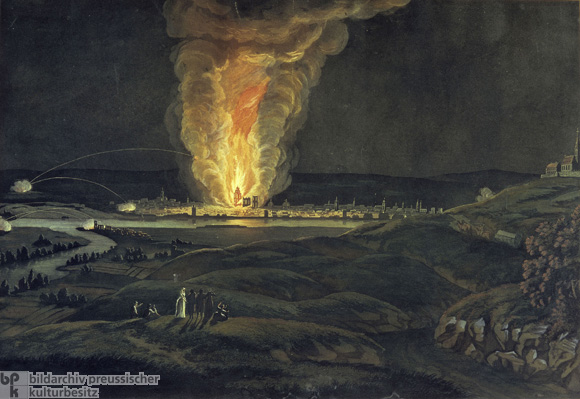Ironically, it was the moderate faction of the Girondins rather than the radicals who had recklessly led the French into war in April, 1792 (Robespierre famously warned that people tend not to be fond of missionaries with bayonets). Initially, the conflict went badly. As the situation deteriorated in August, the people of Paris overthrew the monarchy. The fall of two key frontier fortresses left the country open to invasion, and led to the “September Massacres” of suspected counterrevolutionaries.
The situation changed dramatically when the revolutionary army held its ground and scored a stunning symbolic victory over the seasoned Prussian troops at Valmy on 20 September. The National Convention declared France a republic two days later. Thereafter, the French went over to the offensive. General Custine’s Army of the Vosges captured Speyer, Worms, Mainz (21 October), and Frankfurt in barely a month, mainly because the easily panicked French troops faced little opposition.
The Mainz episode came to epitomize, for contemporaries and later generations alike, the perils and promise of revolution, not least the political engagement of “intellectuals.” Then as now, internal developments commanded the most attention, and the political significance outweighed the military. Debates over the past have a way of becoming arguments about the present and future.
Local radicals founded their own Jacobin Clubs and, in collaboration with the French troops now promising liberation to all peoples seeking assistance (19 Nov.), set about overthrowing the old social order on the left bank of the Rhine. The results were mixed: a bold experiment in democracy that drew support from a wide social spectrum but never became truly populist or practically successful. The conditions were not auspicious. As the idealism of the revolutionary leaders, many of them intellectuals or former officials, collided with the reality of public skepticism or hostility, frustration and French power-political needs led to ever more coercive measures, recapitulating the transition of the Revolution itself from liberalism to authoritarianism. Finally, the new “Rhenish-German National Convention” declared an independent republic (18 March) and then humiliatingly and almost immediately (21 March) sought union with France, which had discovered a belief in “natural” frontiers.
Emergency coinage from the siege of Mainz, issued by decree of May 1793
coins of similar design were struck in three denominations—1, 2, and 5 sols—in copper, bronze, and bell metal
left: obverse, derived from a coin of the constitutional monarchy, adapted with republican language
right: reverse, denoting the denomination, and bearing the legend, coinage of the siege of Mainz
Within a fortnight, the high hopes seemed a cruel illusion. Threatened by Coalition forces, Custine had been forced to withdraw the bulk of his troops. The Allies encircled Mainz on March 30, invested it on April 14 and began shelling it on June 18. The bombardment became a sort of horrible spectacle for the population of the surrounding region.
The city finally fell on July 23. Physical damage was tremendous. The author Johann Wolfgang Goethe, who accompanied the Coalition troops in 1792 and 1793 observed:
Here we found the most lamentable state of things. Ashes and ruins were all that was left of what it had taken centuries to build. . . . The mind became distracted at the sight—a much more melancholy scene than that of a town burnt down by accident."The departing French pledged not to engage the Allies for one year, and many joined the revolutionary armies of the west, where their skill contributed greatly to the crushing of the Vendéan revolt. The fate of their German collaborators was less gentle, ranging from harassment to prison terms, exile, and lynching. The most celebrated primary source is the account by Johann Wolfgang Goethe, who accompanied the besiegers but displayed great empathy for all participants (especially civilians) and a spirit of reconciliation all too rare among the victors. He several times intervened to protect local revolutionaries from attack. Confronting a man who "swore deadly vengeance against the Clubbists,"
I advised him to use milder language, and represented to him that the return to a peaceful and domestic state of things should not be destroyed by a new war between fellow-citizens, and by feelings of hatred and revenge, as otherwise our misfortunes would never end;The fall of Mainz, combined with other blows that summer, from the assassination of Marat to the spread of bloody rebellion in both the west and south of France, precipitated the levée en masse and escalation of the incipient Terror. The siege of the city marked the beginning of a series of foreign military setbacks that would stretch from April 1793 to June 1794. Not coincidentally, the turn in the tides of military fortune eventually brought about a softening of support for the Terror and the overthrow of Robespierre and his faction in July. Mainz changed hands several times in 1794-1795, but under the Treaties of Campo Formio (1797) and Lunéville (1801) returned to France and became the Prefecture of the Department of Mont-Tonnerre. In 1814, Mainz was restored to German sovereignty.
Although one should beware of exaggerating the importance of the Mainz revolution, it was the first modern German democratic movement. The problems it posed—the strengths and limitations of both force and idealism, the challenge of implanting democracy under occupation, and the dilemma arising when the majority will rejects democracy—remain topics that we continue to debate in both the military and political realms.
(adapted from a piece I published earlier in another setting)




No comments:
Post a Comment